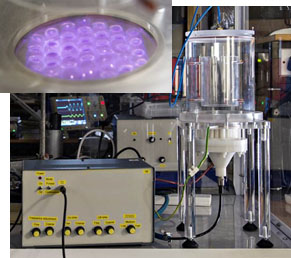Real World Interactions
Microbubble-enhanced plasma-driven advanced oxidation processes
 Microbubble-enhanced plasma reactor and view of the plasma through the membrane at the gas-liquid interface.
Microbubble-enhanced plasma reactor and view of the plasma through the membrane at the gas-liquid interface.Recently, cold atmospheric-pressure plasmas (CAPs) have emerged as a novel technology with great potential for wastewater treatment due to their strong oxidative capability. With inert and readily available gases such nitrogen, oxygen or simply air as the only consumable, CAPs deliver a mixture of highly oxidizing biocidal species, such as hydroxyl radicals OH, atomic oxygen O, hydrogen peroxide (H2O2) and ozone (O3). In this project, CAP will be used in combination with microbubble generation technology to develop a novel advanced oxidation process. Microbubble generation has been demonstrated to be a scalable technology that enhances mass transfer between the gas and liquid phase and is, to quote just one example, currently in use in municipal water treatment plants in the UK for enhanced water aeration. In this project microbubbles will be generated by combining a fluidic oscillator with microporous membranes which also act as electrodes for the generation the plasma. The novel configuration produces the plasma at the gas-liquid interface of the bubbles; hence facilitating the transfer of oxidative species produced in the plasma directly to the liquid phase.
Staff: F Iza
